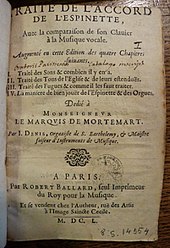Denis (harpsichord maker)
Members of the Denis family were French harpsichord makers from the mid-16th century. At the beginning of the 18th century they were succeeded by members of the Blanchet family as the most important dynasty of harpsichord builders in Paris .
Members of the Denis family led the instrument makers' guild for several generations, but only four harpsichords and three spinets made by members of the family have survived to this day. Many of the instruments of the Denis family bear the manufacturer's signature in red chalk under the soundboard. The name of the manufacturer, the place and date and three stars with five points were noted. The instruments of the Denis family were highly valued even after their time, as an entry in the Encyclopédie méthodique from 1785 shows: "The best harpsichord makers were the Ruckers from Antwerp [...] and Jean Denis from Paris".
Known members of the family
There are records of the following members of the family as instrument makers:
Robert Denis I (1520–1589), built spinets in Paris
- Claude Denis (1544–1587), son of Robert I.
- Robert Denis II († 1589), son of Robert I.
-
Jean Denis I (around 1549–1634), son of Robert I, was elected Jurés of the instrument makers' guild in Paris in 1601
- Thomas Denis (around 1585–1634), son of Jean I.
- Pierre Denis I (around 1600–1664), son of Jean I.
-
Jean Denis II. (1600–1672), son of Jean I. He was the organist of the Saint-Barthélemy church on the Île de la Cité (was destroyed), also an instrument maker and in 1647 was elected jurés of the instrument makers' guild in Paris. In 1643 he published a practical treatise on tuning a harpsichord: Traité de l'accord de l'espinette . Today this is one of the most important sources of how harpsichords were historically tuned. It also touches on other topics ranging from choral music to the bad habits of harpsichord players. An instrument with two manuals , which is currently in the Musée de l'Hospice Saint-Roch in Issoudun , has been preserved from him.
- Jean Denis III. (around 1630–1685), son of Jean II, a spinet from 1667 has been preserved from him. He was nominated for the office of jury of the instrument maker Gilde, but not elected.
- Louis Denis (1635–1710) son of Jean II., Two harpsichords, one from 1658 and one from 1677, and a spinet from 1681 have been preserved from him.
-
Philippe Denis († 1705) son of Jean II, a harpsichord and a virginal in the shape of an Ottavini have been preserved from him.
- Pierre Denis II (1675 – after 1705), son of Philippe.
Web links
- Detailed photographs, X-rays and documentation of the instrument built by Louis Denis in 1677 in the Cité de la musique , Paris (French)
- Photos and a description of the spinet built by Louis Denis in 1664 (French / English)
- Photos and a description of the 1674 by Philippe Denis built harpsichords (English)
Individual evidence
- ↑ Entry No. PM36000130 in the Base Mérimée of the French Ministry of Culture (French)
- ↑ Edward L. Kottick: A History of the Harpsichord . Indiana University Press, Bloomington 2003, ISBN 978-0-253-34166-2 , pp. 168-171 (English).
- ^ François Badoud: The Louis Denis harpsichord, 1658 restored by Reinhard von Nagel (2004-05) ( Memento of September 1, 2011 in the Internet Archive ). Translated by John Tyler Tuttle (English).
- ↑ Edward L. Kottick: A History of the Harpsichord . Indiana University Press, Bloomington 2003, ISBN 978-0-253-34166-2 , p. 167 ( limited preview in Google Book Search, accessed July 1, 2017; English).
- ↑ Edward L. Kottick: A History of the Harpsichord . Indiana University Press, Bloomington 2003, ISBN 978-0-253-34166-2 , based on the table on page 166, which shows the known members of the family ( limited preview in Google Book Search, accessed July 1, 2017; English ).
- ^ Igor Kipnis: The Harpsichord and Clavichord: An Encyclopedia . Routledge, 2013, ISBN 978-1-135-94977-8 , p. 148 ( limited preview in Google Book Search, accessed July 1, 2017; English).


